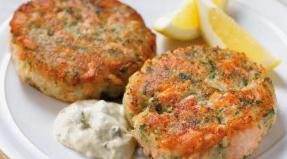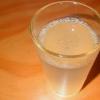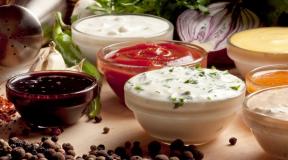How to count calories for weight loss. New Harris-Benedict Equation
Let's get straight to practice.
scales it is best to choose electronic. This will help you know the exact weight. It is easy to check the scale before buying: take a small item (or several items) that you know the weight of and put it on the scale several times. Restart the balance and check again. If the figure does not change, the scales are not lying. Many manufacturers allow +/- 5 grams to be in error. Tables of weights and measures for determining the weight of products are not helpers here: After cooking, the dish will need to be weighed in order to calculate its total calorie content, and then one of your portions.
It is best to choose electronic scales
Calorie tables collection can be found in any bookstore and will always be at your fingertips. Also, the calorie content of the product is indicated on the package. In different tables, the numbers may vary slightly. Pick one table for yourself and use only that table.
All kitchen utensils it is advisable to weigh in advance, so that later you can easily subtract the weight of the dish or plate.
When preparing meals, it is important to remember: calorie content of water, salt- 0 (zero) kcal. But water adds weight and thereby changes the total calorie content of the dish.
The more water you add, the more weight and the fewer calories per 100 grams
The dish you counted once is bigger no need to recount if its composition does not change. Just write down the amount of ingredients you need in your notebook.
And the most important thing - formula to calculate the calorie content in 100 grams of a finished dish:
How to understand the notation in this formula?
A (grams) - the total weight of the finished dish in grams;
B (kcal) - the total calorie content of the food in the finished dish.
How do I use this formula?
We multiply two digits diagonally by each other and divide by the digit that is located diagonally with X:
B × 100: A= the number of calories per 100 g of your cooked meal.
The formula is not very clear? Let's take a closer look at how to put it into practice with detailed examples.
Simple dishes: porridge
Let's start with a simple dish and calculate the calorie content of ordinary rice porridge.

100 grams of rice porridge contains 110 kcal
Ingredients:
... Rice - 300 g
... Water
... Salt
1. 100 grams of dry rice contains 330 kcal.
2. For our porridge, we took 300 g of cereal: 330 kcal × 3 = 990 kcal.
3. The entire volume of cooked rice porridge will have a caloric value 990 kcal: except for water and salt, which, as we already know, have no calories, we did not add anything else.
4. From 300 g of dry rice, about 900 g of ready-made porridge is obtained.
5. We calculate the calorie content of rice porridge in 100 grams by the formula:
900 g rice porridge = 990 kcal
100 g rice porridge= X kcal
990 × 100: 900 = 110 kcal (990 multiplied by 100 and divided by 900)
So, our result: 100 grams of rice porridge contains 110 kcal.
According to a similar scheme, we calculate the calorie content of boiled pasta, beans, lentils. Before cooking, we weigh dry pasta, calculate the calorie content of the dry weight. We boil the pasta, drain the water and weigh the finished pasta: the weight will be greater, since the pasta has absorbed water. Then we count the calorie content in 100 g.
Complex dishes: puree soup and apple sambuc
The calorie content of a multicomponent dish is not much more difficult to calculate than the calorie content of a simple porridge. Let's cook a hearty pumpkin puree soup.

100 g pumpkin puree soup contains 64 kcal
For your convenience, all data are given in the table.
|
Product |
Product weight |
Calorie content in 100 grams |
|
|
Milk 3.5% |
1 l (1000 ml) |
||
|
Potato |
|||
|
Onion |
|||
|
Butter 82.5% |
|||
|
Total: |
1630.5 kcal |
1. The total weight of products that are needed to make pumpkin puree soup - 2675 g.
2. The total calorie content of foods - 1630.5 kcal.
3. In a deep saucepan, fry the onion in butter, then add carrots, potatoes and pumpkin cut into small pieces, pour milk, add salt. Bring to a boil and simmer over very low heat for 30-40 minutes. After that, grind the vegetables together with milk in a blender in mashed potatoes.
4. The weight of the finished dish is 2562 g and contains all the same 1630.5 kcal (I remind you that water evaporates, not calories).
5. According to the formula, we calculate the calorie content of pumpkin soup in 100 g:
2562 g of soup = 1630.5 kcal
100 grams of soup = X kcal
1630.5 × 100: 2562 = 63.6 kcal (round up to 64 kcal)
100 g of pumpkin puree soup contains 64 kcal.
And let's not forget about a light dessert. Today we have on the menu airy apple sambuc with an amazing aroma of cinnamon.
|
Product |
Product weight |
Calorie content in 100 grams |
Caloric content of the prescription product weight |
|
Apples (seeded and peeled) |
|||
|
Egg white |
|||
|
Total: |
479.4 kcal |
1. The total weight of the products that we need to make apple cinnamon dessert - 790 g.
2. The total calorie content of these products is 479.4 kcal.
3. Prepare apple sambuc.

Sambuc is a jellied dessert made from whipped egg whites.
Cut the apples into quarters, peel and remove the seeds. Fold into a mold, pour a couple of tablespoons of water on the bottom, cover with foil and bake in the oven at 180 ° C for about 25-30 minutes (until soft). Cool the finished apples, and in the meantime, dissolve the gelatin as indicated on the package, and heat it to 40-50 ° C, after which we also cool it. Grind the apples with a blender in mashed potatoes, add sugar and beat with a whisk (attachment) or mixer for about 1 minute. Then add egg whites to the apples, beat for at least 5 minutes: the mass will turn white and increase in volume. Then pour in the gelatin and beat for about 1 minute more. Pour the mass into bowls and put in the refrigerator for 3 hours. Before serving, sprinkle with cinnamon, decorate with apple slices and a sprig of mint.
4. The weight of the finished dessert is about 675 g and contains 479.4 kcal.
5. Let's calculate the calorie content of apple sambuca in 100 g:
675 g dessert = 479.4 kcal
100 g of dessert = X kcal
479.4 × 100: 675 = 71 kcal
100 g of apple sambuca contains 71 kcal.
We fry cutlets, chops and meat in batter
When calculating the calorie content of fried foods, there is one key point to consider: 20% the amount of oil you put in the pan is absorbed into the food (cutlets, chops). However, if you fry potatoes, other vegetables, flour products, do not lose sight of the fact that these dishes absorb almost 100% oil... This is especially true of zucchini, eggplant, pancakes, pancakes: they absorb oil like a sponge and all the time require additional "feeding". When you sauté vegetables with the addition of oil, all the oil ends up in your stew. In this case, you need to take into account all the fats used in cooking.

Eggplant absorbs oil like a sponge
I suggest you have a hearty lunch fried chicken fillet with sour cream and garlic sauce.
|
Product |
Product weight |
Calorie content in 100 grams |
Caloric content of the prescription product weight |
|
Chicken breast fillet |
|||
|
Lemon juice |
|||
|
Vegetable oil |
900 kcal - 20% * |
||
|
Salt pepper |
|||
|
Total: |
768 kcal |
* 20% of the indicated calorie content of the oil is 180 kcal, which will be absorbed into chicken meat. The rest of the oil will remain in the pan.
1. To prepare fried chicken fillet, we need 650 g products.
2. The total calorie content of these products is 768 kcal.
3. Let's start preparing dinner. Cut the chicken fillet lengthwise into two parts and beat off slightly. Salt, pepper, sprinkle with lemon juice and leave to marinate for 20-30 minutes. Then fry in vegetable oil on both sides until golden brown. Let's prepare the chicken fillet sauce. Ingredients to taste in the quantities you need: sour cream, garlic, herbs, salt. Squeeze the garlic through a press, chop the herbs finely, combine with sour cream, add salt and mix. Or grind all the ingredients with a hand blender. The calorie content of sour cream sauce will be equal to the calorie content of your sour cream: herbs and garlic are very low calorie foods.
4. The weight of the chicken fillet after cooking is about 400 g and contains all the same 768 kcal.
5. Now let's calculate the weight of fried chicken fillet in 100 g according to the formula:
400 g Fried Chicken = 768 Calories
100 g fried chicken = X kcal
768 × 100: 400 = 192 kcal
In 100 g of fried chicken fillet, we have 192 kcal (excluding the calorie content of sour cream sauce).
If you want to cook meat in batter, then you need to add the calorie content of batter (flour, milk, egg) to the calorie content of meat and vegetable oil.
How many calories are in broth and compote?
When cooking, part of the calories is transferred from the products to the broth: from fish - 15%, from meat - 20%, fruits - 30%, dumplings, manti and khinkali - 20%. These numbers can fluctuate: it all depends on the preparation time of the products.
Let's calculate the calorie content of salmon fish broth. Take a 300 g salmon steak and 1 liter of water. The calorie content of salmon in 100 g = 142 kcal, in 300 g of this fish = 426 kcal (142 × 3).
426 kcal - 15% = 63.9 kcal (round up to 64 kcal).
In 1 liter of salmon broth 64 kcal... There are only 6.4 kcal in 100 ml of broth!
Boiled meat and vegetables
Today we have dinner boiled beef, a glass of kefir and salad. The calorie content of kefir is written on the package, and we will calculate the calorie content of meat and salad ourselves. With a salad, everything is simple: add up the calorie content of all its components. We count meat.

When cooking meat, about 20% of its calorie content goes into broth.
Ingredients:
... Beef shoulder (boneless meat) - 1 kg
... Salt
1. 100 g of beef shoulder contains 208 kcal.
2. In 1 kg of scapula: 208 kcal × 10 = 2080 kcal.
3. After cooking, the weight of boiled meat is about 700 g: boiled meat has decreased in volume and weight.
4. When cooking meat, about 20% of its calorie content goes into broth, thus 2080 kcal - 20% = 416 kcal, this is how much was boiled into broth from a piece of meat weighing 1 kg, and there are 1664 kcal left in the meat itself.
5. Now let's calculate the calorie content of boiled beef in 100 g:
700 g of boiled meat = 1664 kcal
100 g of boiled meat = X kcal
1664 × 100: 700 = 237.7 kcal
In 100 grams of boiled beef shoulder 237.7 kcal (round up to 238 kcal).
And in conclusion, I want to give you some useful advice: the calorie content of fruit compote (without sugar), broths, coffee and tea (also without sugar), garlic, herbs, many dry spices is so small that you shouldn't focus on it. You will not be able to drink that much broth in a day to catastrophically go over your calorie intake. And, moreover, you are unlikely to overpower so much garlic. But if you cook with fats, then you can reduce the calorie content of the first or second courses as follows: after cooking, remove the oily film from the surface of the dish with a spoon.
Calorie counting may seem daunting at first glance. For the second or third time, you will do better, and after a while you will do it automatically.
Now spring is the most beautiful time of the year when nature awakens. I sincerely wish you to be imbued with a fresh mood and walk briskly towards your goal.
Best regards, Natalie Lissy
Each person is different, and each formula may have an error. You need to choose the formula that will work for you.
Start with the mean, or with a formula that approximates the mean. If the results are not as effective as expected, try sticking to the following value: lower for weight loss, higher for weight gain.
Harris-Benedict equation
Basal metabolism according to the Harris-Benedict formula is determined taking into account gender, age and body size. The equation was first published in 1918. The formula is suitable for men and women over 18 years of age.
This formula has a rather large error - according to the Academy of Nutrition and Dietetics, 90% coincidence of the results with real data was recorded only in 60% of cases. That is, in 40% of situations, the equation may show incorrect data, and, mainly, upward. That is, as a result of the calculation, it may turn out that the need for calories is overestimated and a person begins to consume more calories than he actually needs.
New Harris-Benedict Equation
Due to deficiencies in the basic Harris-Benedict formula, an updated equation was published in 1984. Rosa and Shizgal conducted a study on a large group, and the data was taken from research materials of Harris and Benedict in 1928-1935.
This formula already takes into account the features that in the old formula led to an excess of calories and therefore it was this formula that was more often used to determine the basal metabolism before 1990.
Mifflin Formula - San Geora
Over time, the way of life of people also changes, new products appear, the dietary schedule, physical activity change. A new formula has been developed, it does not take into account the muscle mass of the body, and is also calculated based on height, weight and age. This equation is used clinically to determine calories and basal metabolic rate.
According to research by the American Dietetic Association, the Mifflin-San Geor formula turned out to be the most accurate. In other sources it is considered. that this formula is more accurate than the Harris-Benedict formula by 5%, but it can still give a spread of + -10%. But this equation has only been tested in patients from the Caucasian group and therefore may not be accurate for other groups.
Ketch-McArdle Formula
The formula was not formulated on the basis of weight, but on the basis of lean muscle mass. Thus, this formula ignores the energy to maintain fat and is less accurate for obese people than for athletic people.
If you are in good physical shape, the result of this equation will be accurate enough for you. If you just set foot on the path of improving your figure, use the Mifflin-San Geor formula.
WHO formula
The World Health Organization formula is based on the Schofield formula (gender, age, weight) for height, currently in use. Previously used in the US dietary guidelines. Based on baseline metabolic rate, thermal effects of food, physical activity, and thermoregulation.
Based on body area
The formula is suitable for people over 20 years of age. Resting energy expenditure (or metabolic rate) is proportional to body surface area, usually expressed in kcal per square meter of body surface area per hour (kcal / m2 / m2). Body surface area can be calculated from your height and body weight
Calorie Calculation
Why do you need to calculate the number of calories per day?
The answer is simple - in order to maintain, gain or lose weight, you need to know how many calories your body consumes. If you want to lose weight, you need to spend more calories than you consume. You only get calories if you eat or drink something. And you have to spend calories constantly - for the work of the body itself, for physical and mental stress.
Average number of calories per day
Basically, women need 1500-2000 calories to maintain weight. For men, this value is more - 2000-2500 calories.
How many calories do you need to lose weight or gain weight?
With the help of an online calculator, you can calculate the calorie requirement that you need to exist, and calculate the number of calories for losing weight, gaining or maintaining weight. Calories are calculated based on weight, height, age and activity. Based on the data obtained and your desired weight, the calculator will calculate the number of calories you should consume per day to lose, gain or maintain weight. As a rule, calculations are made by several methods that will show an approximate range. This is done to minimize the error of each individual calculation method.
Minimum Calories Per Day for Weight Loss
Calorie calculation is shown in the Weight Loss column. "Extreme Weight Loss" will show you the lowest possible calorie values for your reference, but these are not recommended. If you reduce the amount of calorie intake below the minimum, then the body will begin to burn not only fat, but also muscle in order to obtain energy. The metabolic rate will drop and even a slight excess of calories will be deposited by the body. In addition, muscles consume several times more energy than fat cells. Therefore, burning muscle does not lead to positive results.
Zigzag calories
The calculation results show a table for calculating calories by day, the so-called "zigzag". It is believed that the best results are obtained by slightly varying the daily calorie intake, keeping the average value.
How to calculate kilocalories
A kilocalorie is a thousand calories. One calorie is how much energy it takes to heat 1 ml of water by 1 degree. But there is also a food or dietary calorie equal to a kilocalorie. On food packaging, the calorie content of the food can be indicated as "kkak" and "calories", and this will mean kilocalories.
Calorie Calculation Example
Anna, office worker, two children. Does household chores when not at work. Go in for sports three times a week. Height 163 cm, weight 65 kg, age 35 years. He wants to reduce his weight to 57 kg. According to the Mifflin-San Geor formula, the daily calorie consumption will be 1,833 kcal, the average being 1918. To lose weight, Anna needs to reduce her daily calorie intake by about 500 calories per day, that is, consume 1,400 kcal.
Should I Eat the Same Number of Calories
You can stick to the same number of calories per day, or you can move 200-500 calories to the previous or next day from the day of training. Also, if the weight suddenly stopped (weight plateau), then the use of calories according to the Zigzag scheme will help to get it off the ground.
Is it possible to lose weight only on a diet?
You can lose weight, but with a decrease in the daily calorie intake, a person loses not only fat, but also muscle. Try to lead a more active lifestyle, do exercises, add small physical activity
Weight loss rate
Weight gain rate
Ideal for increasing muscle mass is considered to be 1 kg per month for men and 0.5 kg per month for women. A large gain will lead to an increase in not only muscle, but also fat
Should I drink water?
Drinking clean water is essential for weight loss.
Warning
All calculations are based on mathematical and statistical formulas. But only a doctor can give an accurate assessment and recommendations. Please consult your doctor before starting a diet or changing your exercise level.
Calorie counting is the most effective weight loss method. When used correctly, it can give 100% results. Knowing the individual daily calorie intake, you can adjust the diet and achieve your goals faster.
Parameters influencing the choice of diet
The diet should be based on the characteristics of the body and the required amount of nutrients. To calculate how many calories you need per day, you should consider:
- level of daily activity;
- age and gender, as men need to consume more calories than women;
- availability of training;
- figure parameters, which include height and weight;
- habitual diet.
Thus, having the necessary calculations on hand and knowing how many calories you need to eat per day, you can adjust your diet and achieve the expected results faster.
Women's and men's daily calorie intake
Fats, proteins and carbohydrates are the three key micronutrients that provide the body with the necessary energy and support biochemical processes.
The female body requires less daily calorie intake than the male. This is due to the inherent genetic ability of rapid weight gain for full procreation.
The average kcal per day for a woman is about 2000 kcal. If it is necessary to lose weight from the indicators of the norm of calories for different age groups of women with different activities and diets, 500 kcal or 10-20% are taken away.
At the same time, the number of calories per day should be reduced gradually, otherwise a sharp decrease in the intake of substances necessary for the body can provoke disruptions in the menstrual cycle, a weakening of the immune system, a slowdown in metabolism or problems with the work of the heart.
In order to determine how many calories a man needs per day, it is necessary to take into account that they have an accelerated metabolism and are prone to rapid weight loss. Therefore, the diet for the male gender should consist of a varied set of foods.
The average daily calorie intake for a man is 2,400 kcal and may fluctuate due to age, exercise intensity, lifestyle and weight. To lose weight, men, like women, need to consume 10-20% less calories than the norm.
The daily requirement for calories, as well as carbohydrates, proteins, fats for working women and men is presented in the table:

How many calories do you need to lose weight?
In order for the body to activate its defense mechanisms, slowing down the metabolism, it should be precisely understood what a calorie deficit is needed for weight loss. Experienced nutritionists advise to calculate how many calories a person should have per day, and then subtract 10-25% from the results.
It is important not to reduce the calorie content of the daily menu below the needs of the basal metabolic rate, since this process of losing weight will be accompanied by loss of muscle mass and general discomfort.
You can create a 40% calorie deficit per day for weight loss in a very fast mode. But it should be remembered that the safe calorie limit without the supervision of a nutritionist and doctor is 1800 kcal for men and 1200 kcal for women. Otherwise, a person will not only lose weight, but will reduce immunity and simply deplete his body.
Online calorie calculator
The daily calorie intake calculator will help you find out:
- how many calories you need to eat per day for the body to function normally;
- how many calories do you need to lose weight;
- how many calories do you need to gain weight.
To calculate calories for weight loss, you must indicate your height, weight, gender, age, level of physical activity. You don't need to do anything else, the online calculator will do everything by itself.
The calculation of daily calorie intake can be made according to two different methods: one of the most modern, according to the Mifflin-Saint Geor formula, derived in 2005, and according to the older, but still popular among nutritionists in our time, the Harris-Benedict formula, known from 1919.
Drying the body
Drying the body is a complex of actions, the implementation of which reduces the percentage of adipose tissue in the body, maximizes muscle relief, and also burns subcutaneous fat.
Drying the body for girls and men consists in cutting back on carbohydrates in the diet, drinking more water, increasing the consumption of high-protein foods and sports nutrition.
According to the advice of experienced nutritionists and trainers, in order to saturate the body with useful elements with protein, it is necessary to consume vegetables and fiber, since they are perfectly combined and enhance the absorption of each other.
To draw up the correct diet, you should calculate the bju online using a calculator. Thus, you can find out not only the individual need for calories, but also the required ratio of proteins, fats, carbohydrates, based on the goal pursued.
Applying knowledge of good nutrition and diet is one of the main factors influencing the process of weight loss. The effectiveness of losing weight depends on many circumstances, but only a comprehensive approach to the existing problem will help to effectively solve it.
Discussion
01/22/2019 14:15:00, NwePR666
How many calories to consume per day for weight loss?
08/29/2018 16:42:03, MarinaSkin day I train
08/11/2018 10:36:23 AM, ViktoriaComment on the article "How many calories do you need per day to lose weight? Calorie calculator online"
Losing weight and dieting. How to lose weight, lose weight after childbirth, choose a suitable diet and communicate with those who are losing weight. About calories. Please do not kick, I am a new person in weight loss. Somehow I didn't bother with this issue before.
Discussion
I generally agree that after the first counting of calories, I also asked myself, "Well, I’m overwhelming," it turned out not. If you write down what you are for several days and then calculate it, you get a decent amount.
I lost 22 kg on DD (Ducan's diet) in six months. Now, while I keep my weight for a month, I am resting on the PP. We need to lose another 10 kg.
All my life I was like an accordion - I lost weight by 10, then added with a plus, since I did not know the rules for maintaining weight, the zhor began, problems began to seize.
Dukan's diet (if you are interested - Ducan's book "I Can't Lose Weight" is a must-read) allowed me to understand how to control my body.
PP with a calorie count is great too, I tried it (whoever chooses what - I like to stick to DD at this stage, but sometimes pamper myself with PP, if anything - I will switch back to the classic DD for weight loss)
To lose weight on PP - no more than 1000-1200 kcal (endocrinologist's memo).
On DD, they eat more, gorge themselves completely, do not count calories. So much protein.
And I specifically consulted with an endocrinologist on the amount of BJU, she confirmed to me that the main thing in losing weight is protein, at least 100 grams, normally up to 150 grams. per day (in KBZHU). Unfortunately, with the problems of my body, which produces increased uric acid, it is impossible to consume protein uncontrollably, urea in the blood rises, it is necessary to take care of the kidneys (drink a lot of water to remove protein by-products). Therefore, I try to keep the rate around 100-110 grams. protein a day. And I get tested periodically.
But many do not have the same problems as me, and they eat protein foods uncontrollably, and lose weight on DD.
If you are a beginner in losing weight, to lose 5 kg, you do not need DD (a diet for those who need to lose 15-20 kg and more, kmk), you can easily choose PP and KBZHU for yourself: 1200 kcal, 100 gr. protein per day, 40-50 fats, the rest will be obtained with vegetables and not every day with starch-containing cereals (complex carbohydrates).
Bananas and grapes are prohibited! It is a fast carbohydrate. All products that contain sugar should be excluded from the composition! Flour and potatoes in any form are prohibited, they are fast carbohydrates!
And you will lose weight!) And then, in order to keep it, you will choose how to eat. If you eat again as before the diet, everything will come with a plus. So decide if you need it. Maybe you shouldn't lose weight at all. And just try not to get better further.
07/27/2018 10:32:51, one auntLosing weight and dieting. How to lose weight, lose weight after childbirth, choose a suitable diet and communicate with those who are losing weight. Good night everyone) Share, losing weight, what do you think KBZHU? There is so much conflicting information on the Internet, my head is already spinning.
I looked in my application, how much of what I eat. I am severely malnourished on protein! Weekends are still back and forth, and weekdays are completely seams. On weekends, somewhere a little less than 90 g of protein per day comes out. On weekdays - 30-40 g. And you need, like, 218. But fat seems to be more than normal. Coals are normal. Or maybe that's right, maybe I don't need so much protein.
Although, all these programs and calorie content are somehow not so calculated for me. They write from 1500 to 2200 kcal. And I have a little more than 1300, and then the weight goes very slowly.
Calorie counter and BJU. Need some advice. Losing weight and dieting. How to get rid of excess weight, lose weight after childbirth, choose the appropriate borscht is already registered in the application, you can take the calorie content from there, or you can, of course, calculate how much of what is there, but it will take too long.
Discussion
FatSecret rules, IMHO. I especially like that many dishes are already packed there - dishes from cafes and cookery. But there is also a "pure product", in case you cook yourself. Sometimes it is difficult to calculate when by yourself. Here you cook, say, borscht - a whole pot for a family. Eat yourself, say, two spoons or 10 - and how many kcal are there? The borscht has already been registered in the application, you can take the calorie content from there, or, of course, you can calculate how much of what is there, but it will take too long. And if you wanted to pervert and cook Tom Yam? :) and he is there :) This program definitely helps me.
Need some advice. Losing weight and dieting. How to lose weight, lose weight after childbirth, choose the right diet and chat with Thank you very much! This is approximately how it turns out in terms of calories for me now, but I kept thinking that this is a lot for me. I'll see what happens on ...
Discussion
Tell me, have you been eating this way for a long time? Down there, I read that you do not have enough strength for ordinary everyday activities. With a normal diet, energy and building materials should be enough for everything. Building materials come from proteins and fats. Energy - from carbohydrates (and partly from fat). Here you have just a shortage, since there is not enough energy. Hormones rule everything. The lower the calorie content, the stronger the lack of sleep, the more stress the body experiences, the more unfavorable hormonal background for weight loss. First, it is worth finding a full-fledged maintenance calorie, in which the weight will not change, and the strength will be enough for normal household activity. Also improve sleep. And only then (in a state of complete comfort) create a small deficit and subtract 10% for weight loss.
For proteins, you just have normal, quite a sufficient amount, if there is no active sports load and the age is over 40.
But there is a critical shortage of fat! A minimum of 0.8 g per 1 kg of your weight is required.
There are also few carbohydrates. This amount of carbohydrates reduces the efficiency of protein absorption, reduces the functional activity of the brain and contributes to stress hormonal levels, which can lead to breakdowns.
The total calorie content is clearly underestimated. You need to calculate the adequate calorie content, look here [link-1]
After calculating the total calorie content, calculate the amount of protein and fat, the rest of the calories should be carbohydrates, but not less than 150 g.
The daily calorie requirement for your physical. activity is definitely not lower than 2000 kcal, but Or is it all the same? And is there a "norm" of harmfulness in g, in %% that does not greatly affect the process. The main thing is the balance of calories per day. The individual assimilation of products also affects (depends ...
Discussion
Without any sports, sitting at home I lost 1500-1600 calories, how can you eat 1200 with sports ?! And do not forget that for a woman, the lower limit of the norm of body fat is 20%, if you lower it below, then there may be hormonal disruptions
Lack of nutrition makes the body want to put aside a supply of even one cucumber or cabbage. It is necessary to eat in accordance with the costs of the body.
Calorie counting. Need some advice. Losing weight and dieting. To lose weight, a woman needs comfort in everything: a balanced diet with a very small calorie deficit (10-20% of the total calorie intake), physical. activity for pleasure, without fanaticism, full sleep and ...
The idea of losing weight comes to many minds, although a few decades ago this problem did not exist at all. That is, of course, there have always been overweight people, but this was not perceived as some kind of serious drawback. Today the situation has changed - overweight and obesity are recognized as more than just a problem: in 2006, the X International Congress on Obesityheld in Sydney, Australia, acknowledged that overweight should be considered a global(i.e. worldwide) epidemic of a non-communicable naturebecause being overweight has long ceased to be a concern of individuals.
Back in 2006, the World Health Organization reported with alarm that the total number of people who are overweight or obese exceeds 15% of the world's population, with some countries in the world reporting that more than half of their population suffers from this problem. As for 2015, that is, today, the WHO predicted that obesity in the adult population of the world will exceed the level of 700 million people, and at least 2.3 billion people will suffer from overweight.
Since overweight and obesity pose a serious threat to the health of any person, and on such a scale turn into a real danger for all national health systems, not only the desire to look better, but also the World Health Organization calls for weight loss. Serious concern about this problem at the global level has led to the fact that many people strive to lose weight: someone goes to the gym, someone switches to diet food, someone takes part in special weight loss programs.
Interestingly, for almost all losing weight, the question of how to count calories for weight loss becomes very important.... Although the idea of calorie intake can be useful for people who are simply trying to keep their weight at a normal level.
Dangers of being overweight and obese
A hundred years ago, no one would have imagined that the word "epidemic" could be combined with the word "obesity", but today the situation is exactly that. Moreover, overweight in any degree has ceased to be considered an individual concern of each person, but has turned into a problem of a national scale, since it affects the social, medical, and even economic spheres of life and state activities.
As for the social component of the problem of overweight and obesity, then, unfortunately, it is obvious to too many, and starting from early childhood, when plump children of their age are offended by peers in kindergartens, in the yard and in any children's company. The World Health Organization reported with great concern that in 2005 at least 20 million children under the age of five were overweight worldwide, and expressed its concern that the number of overweight and overweight children is constantly increasing. consequently, the associated problems are also growing.
It is much more difficult for overweight adults to find a decent job, since many employers want to have employees of a "representative" type, and this is an indisputable fact. It is much more difficult for these people, and sometimes even impossible, to start a family, most often they have a very limited circle of friends, it is often difficult for them to find the necessary clothes ...
The medical component of the problem of obesity and overweight is probably the most terrible: it is with overweight that doctors around the world and the World Health Organization associate the risks of developing many very serious diseases.
For example, it is known that cardiovascular diseases are more likely to develop in people overweight. But it is cardiovascular diseases that lead among the causes of death and annually claim more than 17 million lives (WHO data).
A direct relationship is also determined between overweight in any degree and type 2 diabetes, a serious disease of the endocrine system. WHO warns national health systems and governments around the world, as well as nongovernmental organizations, that deaths from this cause could increase by more than 50% in the next decade.

In addition, overweight and obesity are becoming one of the reasons for the development of various musculoskeletal disorders, especially osteoarthritis, which can lead to human disability, as well as one of the reasons for the development of some oncological (cancerous) diseases.
We should not forget that in people with obesity and simply overweight, almost all diseases are more difficult, fractures heal more difficult and any wounds and injuries heal. In addition, it has been proven that if a person's weight exceeds normal indicators by only 10%, then the threat of the development of diseases such as atherosclerosis, gout, cholecystitis, metabolic-dystrophic polyarthritis, obesity of the liver and kidneys increases, male potency decreases, the menstrual cycle is disrupted. among women. What can we say about people whose weight is out of the normal range by almost two times, or even more.
Anesthesiologists note that overweight people in any degree perceive and tolerate anesthesia much worse, which is necessary during surgical interventions, and in fact, for people with obesity and with any degree of overweight, diseases of internal organs that require surgical intervention are inherent, and fractures.
And since obesity and overweight are the cause of many health problems, many insurance companies that provide health insurance set higher rates for obese people on their insurance programs ...
Overweight also affects life expectancy: according to medical statistics, grade II obesity reduces life expectancy by about five years, while grade III obesity shortens life by 10-15 years.
Attention! Scientists argue that the average life expectancy of a person depends more on obesity than on oncological diseases: if it was possible to defeat cancer, then a person's life would, on average, increase by one year, and if it were possible to defeat obesity, then people would live longer by four years.
As for the economic component of this issue, some countries also keep such statistics, which cannot but grieve. For example, the losses to the UK economy, which are explained by obesity or overweight citizens of this country, are determined in the range of 13-15 billion pounds per year. And for the United States of America, losses from this problem amount to more than $ 70 billion annually ...
Many countries practically do not keep such statistics, but this does not mean at all that the problem, if it exists, does not in any way affect the economy.
The problem, which was previously considered exclusively aesthetic and cosmetic, is taking on very serious economic outlines all over the world, which are directly related to the medical and social levels of this problem.
What is food calorie content?
The importance of maintaining a healthy weight is almost indisputable, and it is also undeniable that a healthy weight can only be maintained with comprehensive measures. It has been proven that the appearance of extra pounds, which rather quickly turn into overweight, and then into obesity, is influenced by many factors, among which scientists and researchers especially highlight genetic predisposition, environmental influences, metabolic processes in the body, the psychological state of a person, in including a bad mood, a state of fatigue, depressive and other conditions, as well as his lifestyle, that is, food as well. And if a person is not able to influence many of these factors and cannot change them, then nutrition can still be regulated, including control over the calorie content of food.
What are food calories and calories?
As for calories, the cheerful people came up with the following explanation: calories are small and practically invisible pests that invisibly sneak into wardrobes at night and mercilessly suture all clothes. More seriously, calories are the amount of heat that is needed to heat one gram of water by one degree Celsius if the water is heated at standard atmospheric pressure. In addition, calories were used to measure energy and work.
As for the calorie content of food, which is otherwise called energy value, then this phrase should be understood as the amount of energy that the body receives by assimilating certain food products. Accordingly, each product that is used for cooking has a certain calorie content.

It is easy to understand that the more calories the body receives, the more energy resources it receives. And if these energy resources are not used by the body to carry out any activity, then all of them are deposited in the reserve, that is, they turn into fat reserves of the body, which first lead to the appearance of excess weight and then to obesity.
Today there are special tables where the number of calories for each product has already been determined, and sometimes you can find the calculated calorie content of some ready-made meals.
It should be noted right away that it is hardly possible to measure the calorie content of any product or dish at home, since the technique of this process involves the use of special equipment.
Interesting! The energy value, that is, the calorie content, of any product or dish is determined as follows: the product is burned in a special device called a "calorimeter", and then the heat released during the combustion of the product is measured, using a water bath that surrounds the calorimeter to measure the released heat ...
It is known that the caloric content of proteins is 4 kilocalories per gram of the product, the calorie content of carbohydrates is the same, that is, also 4 kilocalories per gram of the product, and the calorie content of fat is 9 kilocalories per gram of the product.
On the packaging of finished products, the calorie content is indicated by the manufacturer, and the calorie content of other products should be checked against special calorie tables.
How many calories does the body need?
It would seem that the fewer calories, the better. But it only seems so, because calories not only get fat - energy is also needed in order for the body to work normally, that is, to ensure the life of the body. This means this - even if a person does nothing, but simply lies in a state of complete rest, that is, asleep, then his cardiovascular system is working, the gastrointestinal tract is working, the person is breathing, some processes are taking place in the nervous, in the hormonal and in all other systems of the body.
And although all these processes are practically invisible, they are very important and really provide the vital activity of the organism, requiring a certain amount of energy for this. It is this energy, which is spent on the life support of the body in a state of complete rest, and is called the basic (or basic) metabolism in the body.

How energy intensive is the basal metabolism? During various studies, it was found that the human body consumes about one kilocalorie per hour per kilogram of mass. That is, a person whose weight is 70 kg will need 70 kilocalories per hour just to ensure the basic metabolism, that is, it will be 70x24 = 1680 kilocalories per day, which are spent by the body only to keep the body alive.
It has been proven that the basic exchange among representatives of different sexes is not the same. The base exchange for women is ten to fifteen percent lower than the base exchange for men. Thus, it turns out that the basic (basic) metabolism in women is 1500 kcal per day (average), and men only need about 1700 kcal per day to ensure the basic (basic) metabolism of the body.
But this is only a basic exchange, that is, when a person does not perform any work, and some additional energy costs are not even taken into account here. For example, if a person has eaten something, then the energy consumption for digestion will increase by about 200 kcal, energy is spent on some even minimal movements - to turn over on the other side, go to the kitchen or to the toilet ... All these are trifles, but energy is consumed and on them.
That is why, when calculating the basic exchange, they often use some averaged figures. In addition, one should not forget that metabolic processes and their rate of course are different for each person, therefore, it is practically impossible to calculate their energy intensity with an accuracy of one kilocalorie.
But in real life, any person is always doing something, and different types of activities require different amounts of energy. It is quite clear that the more intense the work, the more energy is spent on it.
When studying this issue, coefficients were identified with the help of which it is possible to calculate how much energy a person needs for full life. Scientists and practitioners have identified several groups of work (physical activity), depending on its intensity and the required energy costs.
To determine the amount of energy that the body will need, the basic metabolic rate should be multiplied by the corresponding coefficient (the so-called activity coefficient), depending on the group of physical activity on the body.
- The first group of physical activity includes people whose physical activity is minimal, for example, they are office workers or, for example, librarians - that is, people who lead an almost sedentary lifestyle fall into this group. The activity coefficient for such people is 1.2. This means that for women with a basic energy metabolism, which is 1500 kcal, with such a lifestyle, 1500x1.2 = 1800 kcal per day will be required. For men, this figure will be higher, since their base exchange is higher: 1700x1.2 = 2040 kcal.
- The second group consists of people whose lifestyle can be called inactive - sedentary work for such people is combined with a few simple workouts during the week. For them, the activity coefficient is 1.375.
- The third group includes those whose activity is defined as moderate. This can be sedentary work, which is complemented by almost daily workouts, and work that involves not only an office, but also some kind of movement. The activity coefficient for such people is 1.55.
- The fourth group is a group of increased physical activity. The activity coefficient for this group rises to 1.725.
The fifth group includes people whose occupation involves constant significant physical activity, which is comparable to two very intense workouts twice a day. In this case, the activity coefficient is 1.9.
Of course, the activity coefficients make it possible to determine the energy costs of the body only approximately, but it is quite obvious that the secretary girl and the plasterer girl spend completely different amounts of energy, therefore, it should be replenished in completely different ways.
Attention! Experts pay attention to the fact that it is possible to correctly determine the energy requirements of the basal metabolism only taking into account muscle and fat mass. All formulas are designed for the average person, so these formulas are not suitable for determining the basal metabolic rate in people who are very overweight and obese or in bodybuilders whose muscle mass is much higher than that of the average person.
How to lose weight by counting calories?
So, it is known that for a woman who works in an office, 1800 kcal is needed per day. If such an amount of energy enters the body, then the weight should remain in place, because the body will receive everything it needs, but without excess, to store reserves; and without a deficit in order to spend what has already been deferred.
Thus, it turns out that if a person needs to gain weight and round up a little, he should receive a little more calories from food than provided by the basic metabolism and the corresponding formula. But if you need to lose weight, then the number of calories should be less than necessary (calculated using formulas) - then the body will be forced to use internal reserves, that is, it will begin to receive energy from internal reserves of fatty deposits. And if a figure is defined, for example, 1800 kcal, then this means that for losing weight this figure should be reduced, that is, to provide nutrition in which the body receives less energy than is needed to ensure balance.
However, while reducing the energy intensity of food, one should not forget about the basic, or basic, metabolism, which requires a certain amount of calories, and if these calories are not supplied, then incomprehensible and extremely unpleasant metamorphoses can occur with any of the body's organs. That is, even if you need to lose weight, you should not hurt those energy inputs that provide the basal metabolism.
Nutritionists recommend never trying to lose weight too quickly, since the body perceives this as a stressful situation and will certainly try to catch up at the first opportunity - which is why the weight lost during any restrictive diet with such efforts and suffering very often returns, or even increases.
Attention! In order for the result of losing weight to be preserved as long as possible, it is necessary to lose weight very gradually so that the body has time to get used to it and does not feel stress. Nutritionists consider the optimal weight loss to be 0.5 kg per week, which will be about 2 kg per month.
Of course, all processes in the body are very individual, including the process of losing weight, but "miraculous" diets that promise the loss of ten kilograms in ten days are, firstly, unscientific fantasy, and secondly, even if someone then by some miracle it will succeed, then soon all 15 kg will return.
It should be noted that counting calories does not reduce their number, it is just that such counting allows you to control all the time how much energy the body has received.
When deciding to lose weight by counting calories, it should be understood that any heat treatment of the product requires a change in the numbers. For example, the calorie content of 100 grams of rice is about 414 kilocalories, but we are talking about a dry product. As you know, during cooking, rice swells, increases in volume and becomes heavier. That is, 414 kilocalories is the calorie content of not one hundred grams of ready-made rice, but of the entire cooked portion, if exactly 100 grams were cooked. In a word, you will also have to deal with mathematical calculations ...
The calorie content of foods also changes when they are fried or baked, and it is much more difficult to calculate the calorie content of fried or baked foods. It is generally accepted that the frying process increases the calorie content by about 20%, however, different products absorb different fats completely differently, so it is not possible to calculate it with accuracy. By the way, nutritionists recommend giving up fried foods altogether for any diet.
Benefits of Calorie Counting
About the shortcomings of calorie counting, one can say only one thing - you will have to weigh something all the time (at least until the habit appears) and constantly write and count. Of course, constantly walking around with a notebook and writing every glass of juice or every cookie can get bored, but such conditions of this event, at the end of which both a good figure and wonderful health loom and beckon. So you have to try. By the way, many people who are losing weight according to this system, in order not to bother with every candy or various other trifles, practically refuse to take snacks, which, among other things, reduce the total calorie content of food per day.
The undoubted advantage of calorie counting is that people begin to understand that the reason for their excess weight lies not in some mysterious "wide bones" or heredity, but in banal overeating. Well, their bodies don't need so much energy! And for so many years they shoved her in, and even smacked her lips at the same time ... And as soon as the amount of energy, that is, calories, decreases, the body begins to consume the stored reserves and such a long-awaited process of losing weight begins.
Another benefit of calorie counting is that you eat what you want, but keep within a certain number of calories. If you want a cake, then why not. But the trouble is that it is very high in calories, so a slice of cake will mean that the daily calorie limit is almost exhausted. But you can crunch cucumbers or cabbage with almost impunity - their calorie content is very low.
Scientists who have observed people who choose calorie counting say that such people are gradually moving to a healthy diet, since the way a person eats is just a habit. By counting calories, people learn to control and limit themselves, choose less high-calorie foods, and give preference to healthier foods.
Thus, it turns out that daily calorie counting may well ultimately lead not only to weight loss, but also to a healthy diet and a healthy lifestyle.
Many people who, of all diets, opted for calorie counting, say that calorie counting does not limit their choice of foods, and if you suddenly want sweets or ice cream, this is not forbidden, just eating high-calorie foods will significantly reduce the proportion of those remaining in this day of calories and, accordingly, will make you give up something. But this is an opportunity for choice, which for most people is simply of the utmost importance.
Doctors note that weight loss, which involves counting calories, very quickly becomes a habit of controlling everything you eat, and this is much more beneficial than any restrictive or low-calorie diet.
Attention! The essence of any diet is a decrease in the energy value of food entering the body, that is, the desire to force the body to start giving up the accumulated reserves. Counting calories in the daily menu is practically the only way to lose weight that does not provide for any other restrictions other than controlling the total calorie intake during the day.
conclusions
To lose weight or not to lose weight? This has long ceased to be a question that requires reflection, and the problem left the plane of fashion, beauty, aesthetics several decades ago. Today, when even in countries with low per capita incomes obesity has become an epidemic that has taken over even children, the World Health Organization is insisting on the need to maintain a healthy weight.
Of course, a healthy weight depends on many factors, but proper nutrition is one of the first places on this list next to the necessary physical activity. And, probably, calculating the calorie content of the daily menu is not the worst choice in the fight against excess weight, because this is a struggle not only for beauty, but a struggle for health, for the opportunity to lead a fulfilling life, work, have a family ...
Of course, there are diseases in which weight depends on the malfunctioning of the endocrine system, but how many people suffer from obesity simply because of banal overeating, and they continue to stubbornly seize their problems with buns or sausages and further. But the problem of being overweight by itself will not go anywhere ...
And you don't need to limit yourself in anything, you don't need to give up your favorite foods - just count the calories. And now, if the result obtained makes you think, start thinking what is superfluous in the menu, and what you cannot do without. Get started. Try it. And you will certainly succeed, for only the one walking will master the road.
An online calculator of daily calorie intake and BJU will help you understand what rate is needed to maintain shape, gain weight or lose weight. Indicate your options, choose a lifestyle and a goal. The system will make the calculation automatically!



















